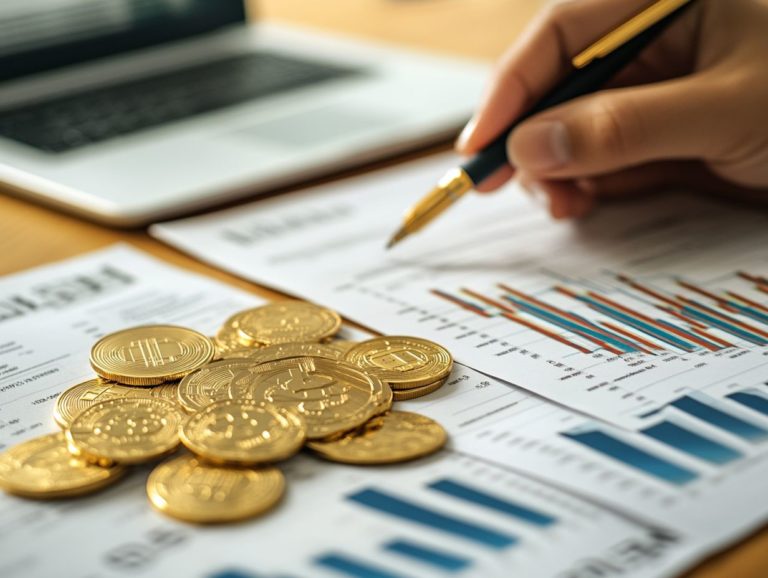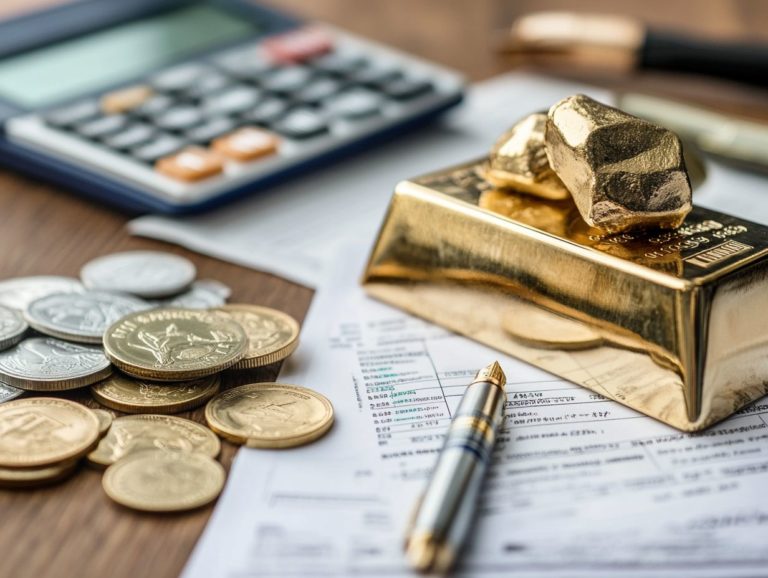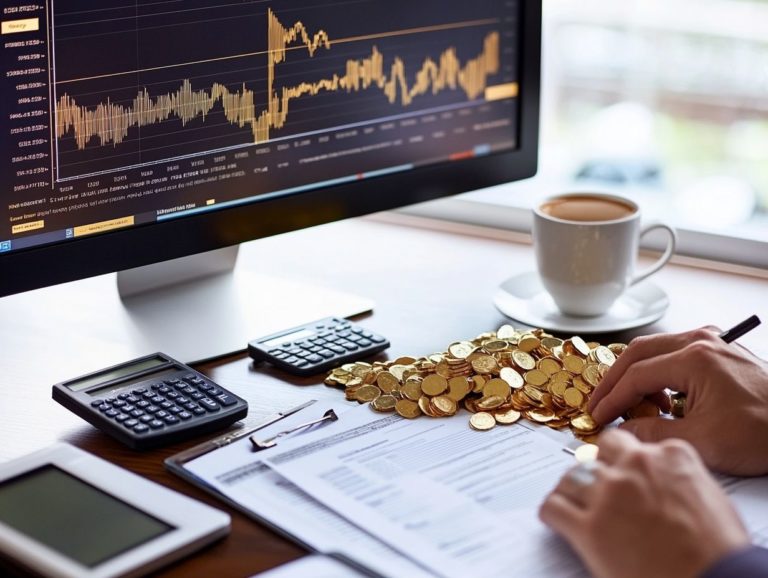The Financial Benefits of Tax-Deferred Precious Metals
Investing in precious metals has long been recognized as a savvy strategy for building wealth and achieving financial stability.
You might not yet be aware of the unique advantages that tax-deferred precious metals can offer. This article delves into the concept of tax-deferred precious metals, shedding light on their financial benefits think tax advantages, portfolio diversification, and a safeguard against inflation.
You’ll learn about the different types of metals available for tax-deferred investment, the various avenues for investing, and the potential risks you should keep in mind.
Read on to see how tax-deferred precious metals can boost your investment strategy!
Contents
- Key Takeaways:
- Understanding Tax-Deferred Precious Metals
- The Financial Benefits of Investing in Tax-Deferred Precious Metals
- Types of Tax-Deferred Precious Metals
- How to Invest in Tax-Deferred Precious Metals
- Risks and Considerations
- Frequently Asked Questions
- What are tax-deferred precious metals?
- What are the financial benefits of investing in tax-deferred precious metals?
- How do tax-deferred precious metals compare to other types of investments?
- Are there any limits or restrictions on tax-deferred precious metals investments?
- What types of precious metals can be held in a tax-deferred account?
- Can tax-deferred precious metals be used for retirement planning?
Key Takeaways:
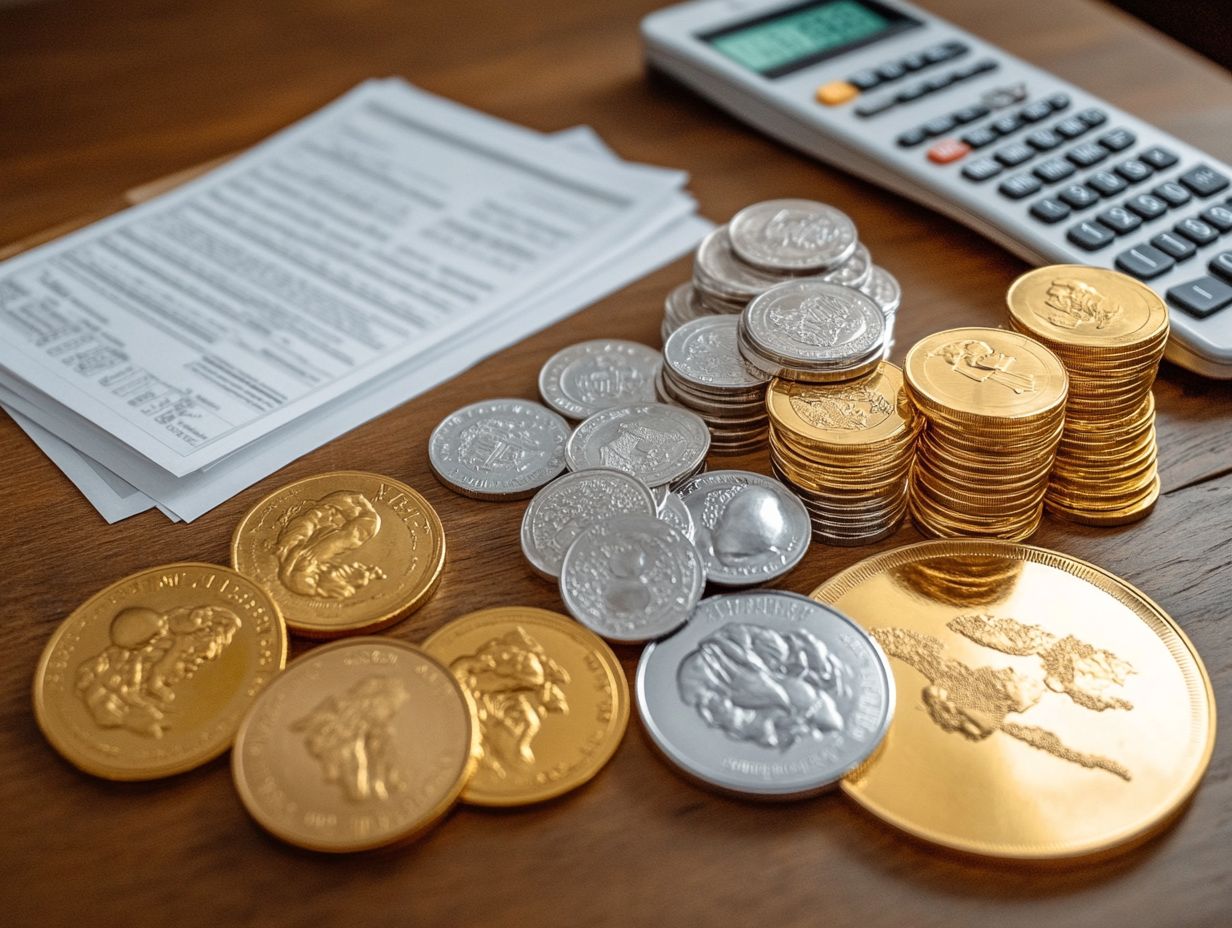
- Investing in tax-deferred precious metals offers financial benefits like tax perks and portfolio diversification.
- Gold, silver, and platinum are top choices, providing stability and potential growth during economic uncertainty.
- Understanding potential risks is crucial for making smart investment choices.
Understanding Tax-Deferred Precious Metals
Tax-deferred precious metals offer a variety of investment options, mainly focusing on gold, silver, and other precious metals. This approach allows you to defer taxes on capital gains until you decide to sell, providing a strategic method to preserve your wealth.
Not only does this enhance your investment portfolio’s performance, but it also serves as a robust hedge against economic uncertainty.
By grasping the intricacies of tax-deferred investments, including IRS (Internal Revenue Service) regulations and the fluctuations in market value, you can navigate your financial assets with greater confidence. This knowledge gives you the power to optimize your investment strategies and make informed decisions that align with your financial goals.
What are Tax-Deferred Precious Metals?
Tax-deferred precious metals represent a unique investment opportunity that allows you to postpone tax liabilities on gains until a future date typically when you decide to sell the asset. This process is often governed by IRS regulations.
These precious metals come in a variety of forms, including gold bars and bullion coins, like the renowned American Gold Eagle and Canadian Gold Maple Leaf. Both of these are favored by astute investors who know their worth.
To qualify for tax deferral, these investments must adhere to specific criteria set forth by the IRS, which carefully regulates compliance.
It s essential to grasp the difference between collectibles and standard investment assets; the IRS classifies collectibles as items such as works of art, antiques, and certain coins, which may carry different tax implications upon sale.
By meticulously navigating these regulations, you can unlock significant financial advantages as you invest in precious metals.
The Financial Benefits of Investing in Tax-Deferred Precious Metals
Investing in tax-deferred precious metals presents a wealth of financial benefits for you. Not only do these investments come with substantial tax advantages, but they also provide opportunities for portfolio diversification.
They also provide strong protection against inflation and economic downturns. Incorporating precious metals into your strategy can be an essential step toward achieving your long-term investment goals.
Tax Advantages
One of the primary tax advantages of investing in tax-deferred precious metals is your ability to defer capital gains tax the tax on the profit made from selling an asset until you sell the asset, as dictated by the IRS. This allows you to maximize your returns significantly.
This feature provides a significant financial incentive, enabling you to grow your investments without the immediate burden of taxation. By adhering to IRS regulations and understanding the tax obligations of precious metals, you can sidestep the common pitfalls associated with collectibles, which often face higher tax rates and stricter reporting requirements.
Understanding the distinction between investment-grade metals and collectibles is vital, as investment-grade options typically benefit from favorable tax treatment. By grasping these nuances, you empower yourself to make informed choices and enhance your investment strategy.
Portfolio Diversification
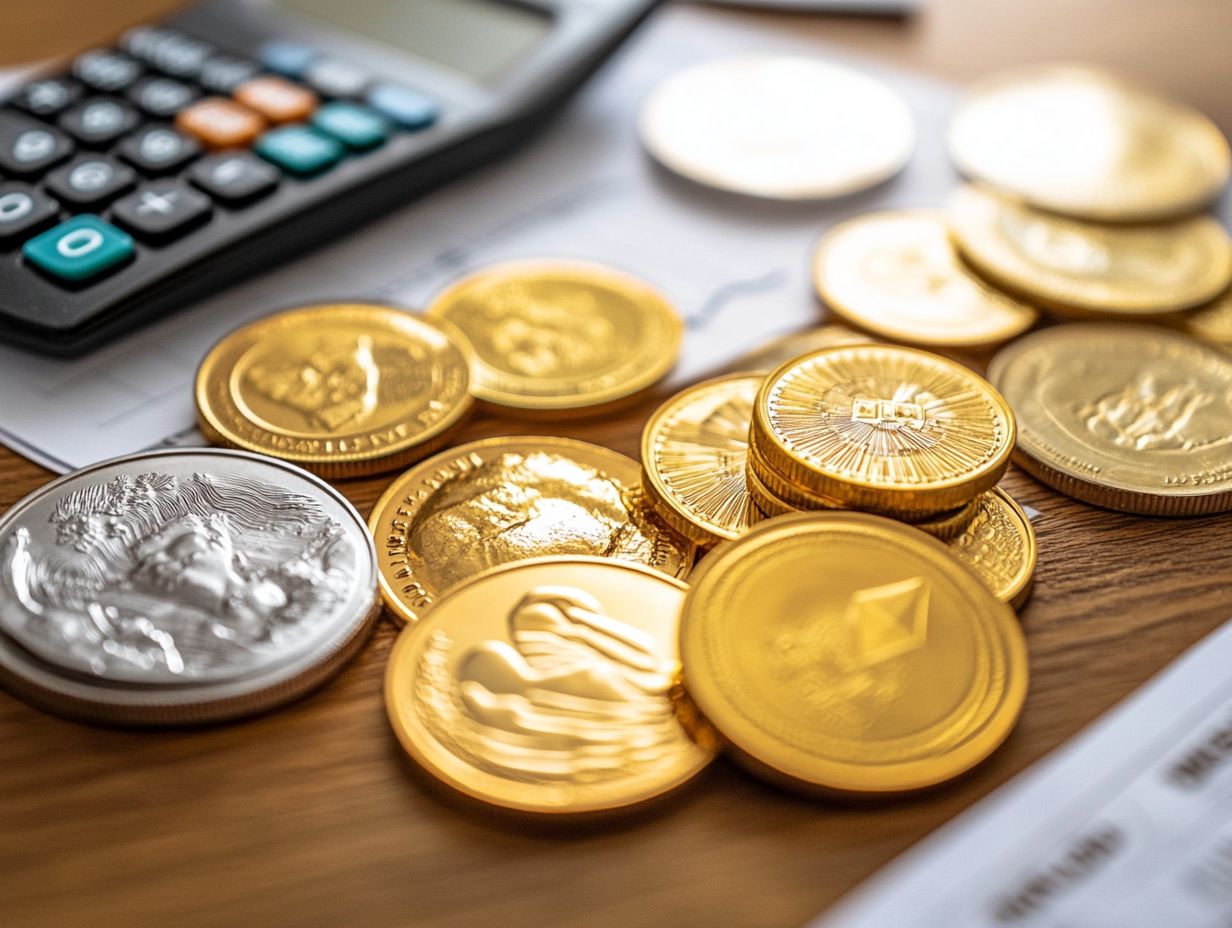
Incorporating tax-deferred precious metals into your investment portfolio can significantly enhance diversification since they tend to behave differently from traditional financial securities across various market trends.
This unique quality makes them an appealing choice for those looking to mitigate risks tied to economic downturns or market volatility. Unlike stocks and bonds, which can swing wildly based on market sentiment, these tangible assets often retain their value or even appreciate during challenging times.
By adding such assets that do not move with the market to your portfolio, you create a more balanced investment strategy one that protects against inflation and instills a sense of security amid unpredictable environments. As global economic conditions fluctuate, these metals often act as a safe haven, offering potential refuge amid the chaos of other investment options.
Protection Against Inflation
Tax-deferred precious metals offer a strong shield against inflation and economic uncertainty, preserving their value and often appreciating when other financial assets stumble.
Throughout history, investors have sought refuge in precious metals like gold and silver during economic distress, as these tangible assets possess an intrinsic value that market volatility struggles to erode. During the inflationary periods of the 1970s, gold prices soared, showcasing its reliability as a store of wealth. Economic data indicates that when consumer confidence dips and inflationary pressures rise, demand for precious metals tends to spike.
Therefore, precious metals not only act as a safeguard against depreciating currencies but also serve as an anchor for your financial stability amid the stormy seas of market upheaval.
Types of Tax-Deferred Precious Metals
The categories of tax-deferred precious metals include gold, silver, and platinum, each with unique features and market values that make them attractive investment opportunities.
Gold
Gold stands out as one of the most coveted tax-deferred precious metals, celebrated for its investment-grade status and substantial market value. Consider products like the American Gold Eagle, which present a unique opportunity for capital gains.
This precious metal has long been a trusted safe haven for wealth, serving as a hedge against economic uncertainty and inflation. As an investor, you’ll appreciate its remarkable ability to retain value over time, making it an ideal choice for diversifying your portfolio.
With tax-deferred accounts, you can enjoy the advantages of gold while delaying taxes on capital gains until withdrawal, potentially enhancing your overall returns. The timeless allure of gold, paired with its consistent market performance, underscores its vital role in navigating financial landscapes. Additionally, understanding the tax benefits of investing in precious metals as a hedge further reinforces its investment-grade products as a reliable and astute strategy for wealth preservation.
Explore your options today and secure your financial future with precious metals!
Silver
Silver, especially in the form of U.S. 90% silver dimes and other investment-grade options, is gaining traction as a tax-deferred precious metal. It capitalizes on market trends to deliver reliable returns in challenging economic times.
This heightened interest comes from the metal’s historical significance and its capability to protect your money from losing value over time. As economic uncertainties rise, many investors like you are gravitating toward silver for its aesthetic charm and its potential to safeguard wealth over the long term.
U.S. 90% silver dimes, for example, are readily accessible and boast an established market. This ensures easy liquidity when you need funds. This accessibility becomes vital during periods of market volatility, where traditional assets may struggle, offering you a tangible alternative that often outshines other investments in a declining economy.
Platinum
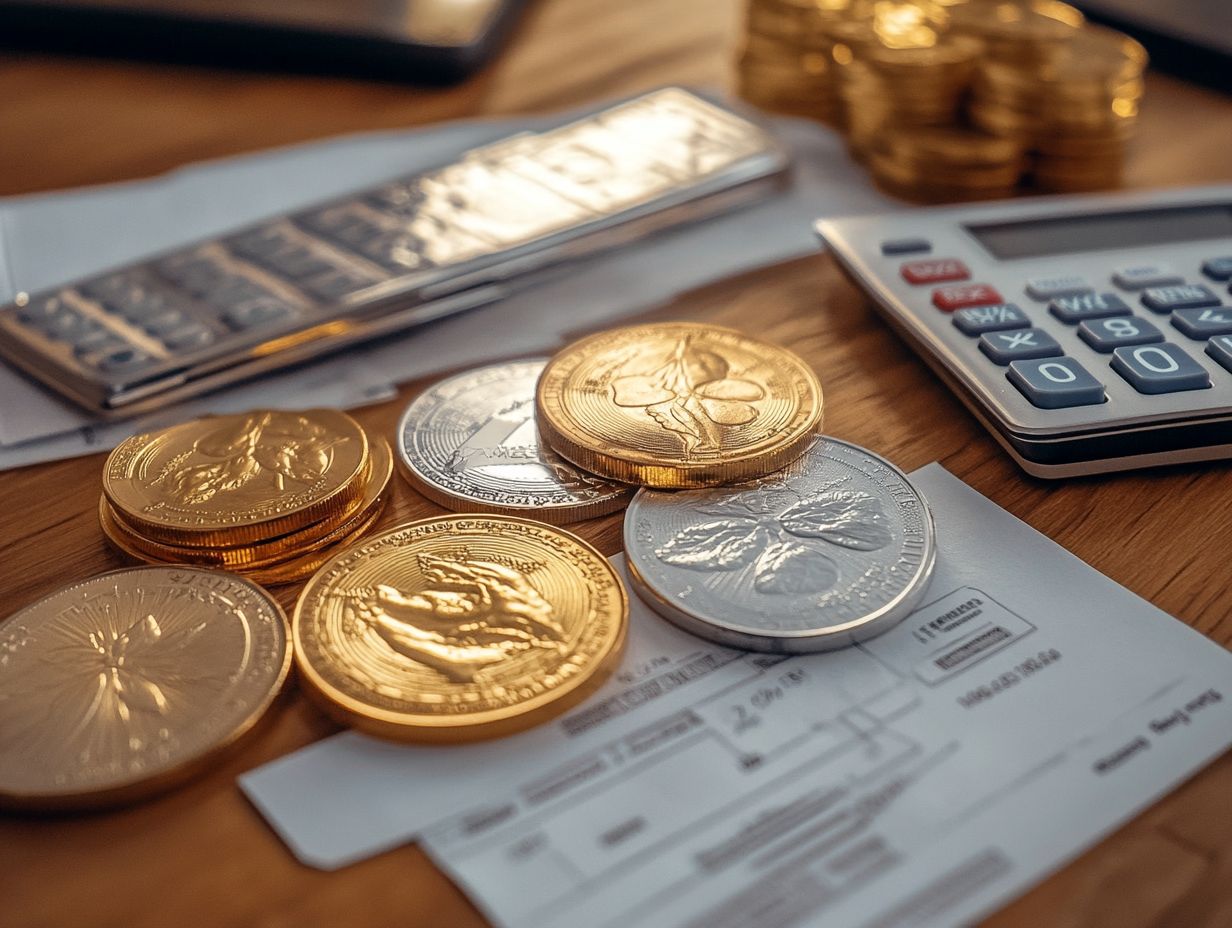
Platinum, while not as ubiquitous as gold or silver, stands out as a valuable investment-grade precious metal. It offers distinct market value and potential advantages, particularly during times of economic uncertainty.
Often viewed as a way to protect your money from losing value over time, this metal has a wide array of industrial applications, especially in automotive catalytic converters and electronics. This makes it an exciting part of your investment portfolio.
For investors aiming to bolster their financial stability, the rarity and increasing demand for platinum can lead to price appreciation over time. During economic downturns, platinum often retains its charm, occasionally even outshining other precious metals.
This makes it a compelling option for those looking to diversify their assets while skillfully navigating the ebb and flow of the markets.
How to Invest in Tax-Deferred Precious Metals
Investing in tax-deferred precious metals offers a range of strategies for you to consider. This includes purchasing through a self-directed IRA, a type of retirement account you manage yourself, understanding the ins and outs of storage fees, and choosing investment options that align with your financial goals.
Each of these components plays a crucial role in crafting a tailored approach to your investment journey.
Options for Purchasing and Holding
When you decide to purchase and hold tax-deferred precious metals, you have numerous options at your fingertips, ranging from online dealers to local coin shops. It s essential to select investment-grade products while keeping an eye on storage fees and insurance. Act quickly to secure the best investment options before prices rise!
Navigating the precious metals market can feel daunting, but investing time to research and compare different purchasing avenues is vital. Prioritize finding reputable dealers who are transparent about their practices and offer certified products.
Understanding storage fees is just as important; these costs can fluctuate significantly based on whether you choose to keep your metals at home, in a safe deposit box, or with a secure third-party facility.
Ensuring the quality of your investment-grade products like bars and coins that meet specific purity standards will help protect the value of your portfolio over time.
Risks and Considerations
Investing in tax-deferred precious metals presents unique risks and considerations that you must evaluate carefully. Factors such as market volatility, economic downturns, and your personal investment objectives should all play a crucial role in your decision-making process.
Potential Risks and How to Mitigate Them
Investing in tax-deferred precious metals comes with risks like market volatility and price fluctuations.
Economic downturns can also greatly influence your investment strategies and returns.
Stay informed about broad economic trends and their impacts on the precious metals market.
Geopolitical tensions, inflation rates, and shifts in monetary policy can trigger sudden changes in metal prices.
These unpredictable elements may lead to unexpected losses.
To protect your investments, diversify your holdings in the precious metals category.
Spread your assets among gold, silver, platinum, and palladium. This approach effectively reduces risk.
Incorporate thorough market analysis to enhance your decision-making in tough times.
Frequently Asked Questions
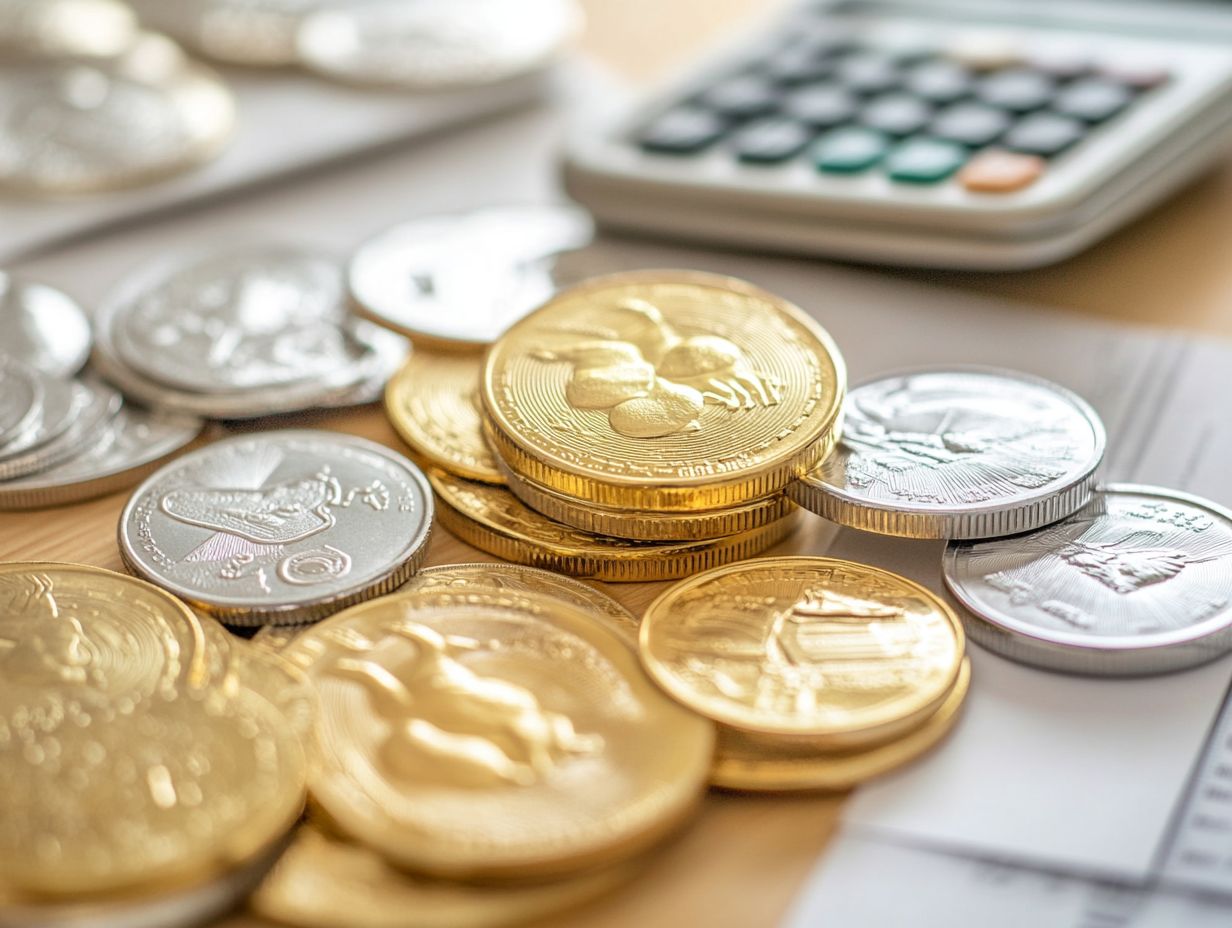
What are tax-deferred precious metals?
Tax-deferred precious metals refer to any type of precious metal investment that allows for tax deferral. This means that taxes on any gains made from the investment are not due until the assets are sold.
What are the financial benefits of investing in tax-deferred precious metals?
The main financial benefit of investing in tax-deferred precious metals is the potential for higher returns due to the tax deferral. This allows investors to keep more of their profits and reinvest them, leading to greater overall gains in the long run.
How do tax-deferred precious metals compare to other types of investments?
Compared to other types of investments, tax-deferred precious metals offer unique benefits such as hedging against inflation, diversification in a portfolio, and potential for long-term growth.
They also have the advantage of being tangible, physical assets that can hold their value during economic downturns.
Are there any limits or restrictions on tax-deferred precious metals investments?
Yes, there are certain limits and restrictions that apply to tax-deferred precious metals investments. For example, there are contribution limits for certain types of accounts, such as a self-directed IRA, and there are penalties for early withdrawals.
It is important to consult with a financial advisor or tax professional before making any investments.
What types of precious metals can be held in a tax-deferred account?
Several types of precious metals can be held in a tax-deferred account, including gold, silver, platinum, and palladium. These can be in the form of coins, bars, or other investment products.
It is important to note that there are strict regulations on the purity and authenticity of these metals for tax-deferred purposes.
Can tax-deferred precious metals be used for retirement planning?
Yes, tax-deferred precious metals can be a valuable addition to retirement planning. They can provide a hedge against market volatility and inflation, and can potentially offer higher returns compared to traditional retirement investments.
However, it is important to carefully consider and diversify your investments for a well-rounded retirement plan.











